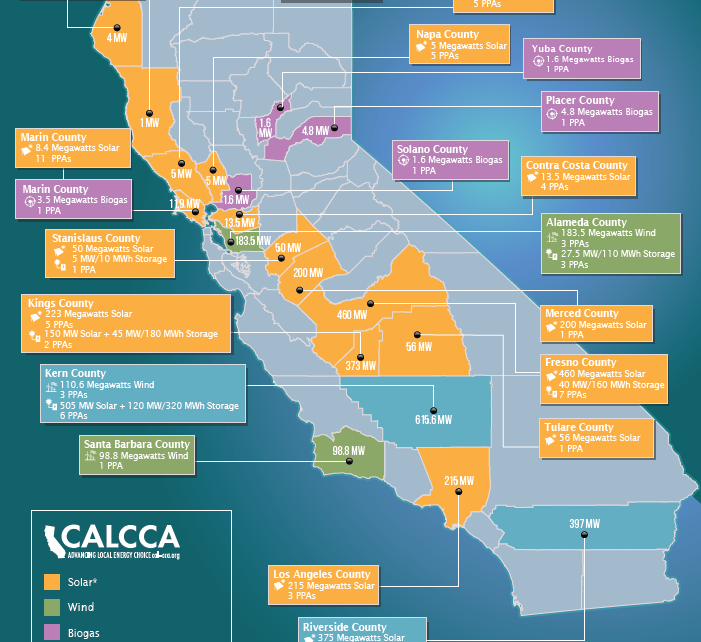
Community Choice Aggregation in California. (Photo: cal-cca.org/cca-impact)
Too Much Green Power Worsening Blackouts
Green power-buying cooperatives in PG&E area are worsening problem
By Wayne Lusvardi, August 20, 2020 10:58 am
The wave of power outages in California during the heat wave of 2020 are mostly in the PG&E power grid area where 21 local green energy-buying cooperatives (called Community Choice Aggregators) are buying green power and green jobs for their communities. These co-ops buy power for 10 million customers in 170 cities and counties and their goal is 100 percent green power by the 2030’s.
California depends on 25 percent imported power, mainly hydropower, from other states. However, the grid operator has been unable to buy much imported power during the regional heat wave. The only remedy for this problem is a diverse mix of power sources with green power no more than 20 to 30 percent of the mix. This heat wave shows the folly of shifting to 100 percent green power during hot spells.
Even Gov. Gavin Newsom has been forced to admit green power falls short and blames planners. But the power grid has been deregulated and decentralized to allow local communities to buy their own power, resulting in a lack of diverse enough power sources during hot weather.
Source of Power Outages Claim to be Unknown
The New York Times of August 16 reports that “Rolling Blackouts in California Have Power Experts Stumped.” Bill Powers, a San Diego power engineer stated, “This should not have caused blackouts.”
The technical reason for the rolling blackouts was the California Independent System Operator (Cal-ISO) could not find enough power reserves from out-of-state hydropower suppliers after three in-state power plants had to shut down and wind power dropped as it typically does during the daytime.
The reason for the high demand for electricity is obviously the heat wave combined with humidity that spiked the temperature to 130-degrees in Death Valley. This resulted in a Stage 3 alert where mainline electric utilities had to ask customers to curtail use or they would start cutting power by rolling blackouts. The ISO asserted it was not grid congestion or downed power lines from wildfires, but a true lack of available power plants to come online when other plants failed, causing the shortage.
Contributing to the blackouts was that California depends on 25 percent of imported power from other states, mainly hydropower to reduce smog in air basins. But the entire southwest was hot leaving little surplus power available.
Blackouts Are Mainly a PG&E Thing
The power shortage has a geographic location: mainly in PG&E territory in Northern and Central California (see data below). There were 99 power outages in PG&E’s customer service area on August 18 at 7:15 pm, equating to one outage for every 51,515 customers. But San Diego Gas and Electric (SDG&E) had only 3 outages. Southern California Edison had multiple outages but does not provide data or location of the number of outages online.
In comparison, Arizona Public Service has 2 outages or 1 outage per 600,000 customers, mainly due its greater diversity in power sources.
Power Outages August 18 – 7:15 pm
Diverse Mix of Energy Sources Avoids Blackouts
Jill Hanks stated in an article, “Insight into how Arizona Power Company Avoids Blackouts as California Remains on Flex Alert,” that the key to avoiding blackouts is a diverse energy mix.
This can be especially seen in Arizona Public Service (APS) capability of tapping 18 percent of “dirty” coal power that was not available to California electric utilities. Moreover, APS still relies on 50 percent natural gas power, compared to 29% for SDG&E and 0 to 17 percent for PG&E. Natural gas power plants start-up faster and can produce power 24 hours/day compared to wind mainly at night (about 4 hours) and solar power (about 10 hours per day).
Green Power Not a Fit for Nighttime Peak Market
Exacerbating the crisis is the new green energy grid because the peak hours for electricity use are from 6:30 pm to 10 pm when solar and wind are not available. This is called the “Duck Curve” because the time demand energy use profile looks like the silhouette of a duck. So, a green power grid is not a fit for the dual peak load market – peaking at midday and again at sunset. Thus, California’s blackouts are a structural failure not a market.
Green Power Co-Ops Worsen Problem
The institutional source of the blackout problem is the proliferation of community energy-buying cooperatives (called Community Choice Aggregators) in local areas instead of the monopoly utility companies like Pacific Gas and Electric (PG&S), So Cal Edison and San Diego Gas and Election (SDG&E) buying power for customers in their service areas.
This is shown in the data above where Marin Clean Energy, a green power buying co-op for Marin County, depends on 74 percent green power (including hydropower).
Gov. Newsom is calling for an investigation of what happened. One of the items that should be researched is how much energy are green power-buying co-ops buying out of state (especially hydropower), which may not be available in a heat wave. But the recent rolling blackouts have exposed the green power goal of 100 percent green power as a recipe for power crisis after power crisis waiting to happen. There will be stiff resistance to taking green jobs away from local politicians in order to make the power grid more diverse and reliable.
Decentralizing the buying of power to local communities instead of monopoly public utilities, is highly popular because it gives local politicians the ability to buy votes with green power jobs for their cities and counties. It was former speaker of California’s Assembly who in 1963 famously said: “money (and jobs) is the mother’s milk of politics”. California blamed “deregulation” for the Energy Crisis of 2001, which was caused when Pres. Bill Clinton’s 1996 EPA mandate to close old, dirty coastal power plants owned by public utilities in California to clean the air by 2001. But no one is mentioning the word “deregulation” now, despite the green decentralizing of power sources in California.
Contrary to former Gov. Jerry Brown’s mantra, small and local is not always beautiful.
- Peter Gleick’s National Water Plan for California - October 12, 2020
- Court Opens Up Big Prop.13 Loophole for ‘Public Franchise Fees’ - October 2, 2020
- New Cal Grid CEO is Ex-Enron Green Power Trader - September 29, 2020

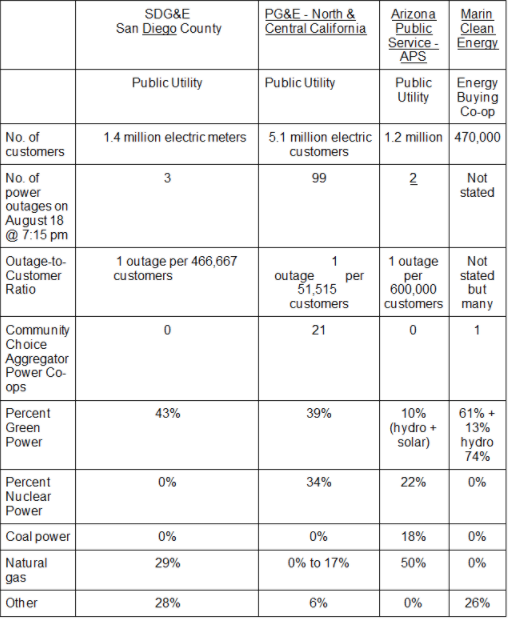

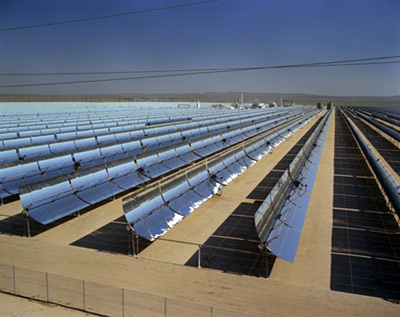
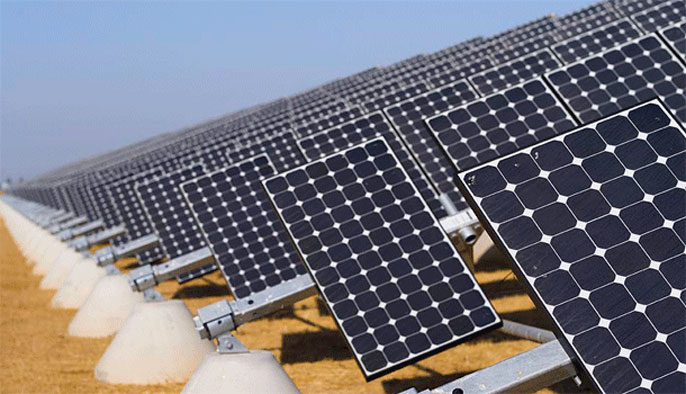
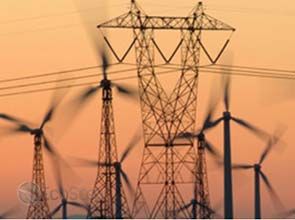
If the “experts” are stumped then they are not really experts are they? Just about everyone that is not an “expert” saw this coming. I suppose “expert” is defined as someone who is 100% green rather than having actual engineering expertise.
Exactly, CW. So it’s a good thing Wayne Lusvardi has weighed in on this, and I’m very glad to see this article, because he IS an expert on this subject if you ask me. He has been writing about it for many years.
You mean California’s virtue signaling is causing rolling brownouts that are hurting people’s actual quality of life, and Grandma’s apartment is 90 degrees at dinner time???
We are led by inept, virtue-signaling idiots like Jerry Brown and now Gavin Newsom and yet CA voters don’t rise up against these fools???
While ineptitude is rampant the real powers behind these policies are not inept but malevolent.
Here, In El Dorado County, many residents have been behind an effort to move to Community Choice Aggregators, not for the “green” aspects, but for the cost savings that other CCAs have found. In Placer County – another County that has communities that has PG&E as a monopoly, but have CCAs available to consumers, their electricity rates are about 10-15% less through a CCA as opposed to rates paid to PG&E.
While allowing consumers the option of selecting generation sources is a component of CCAs, the majority of residents and businesses I’ve spoken with are keenly interested in lower rates, not *green* sources. The cost of electricity in El Dorado County is one of the contributing factors to the El Dorado Hills Business Park’s inability to draw more businesses. Why would a business locate in the EDH Business Park, with PG&E electric rates, when the could locate in Folsom, a few thousand feet away, and pay significantly lower utility rates from SMUD?
Juanito
It is my understanding that the lower power costs at some CCA’s is due to their buying large proportion of cheap locally available hydropower. But if the CCA is buying imported hydropower that is problematically unreliable in a regional heat wave where other states also have need of power for cooling buildings. The simple fact is they are mostly shifting to unreliable green power and not buying nuclear power that is the cheapest and cleanest. Wait until FERC allows mini-nuke plants the size of a small building that may blow solar and wind out of the water because it will be distributed power that does not need a transmission grid, but a distribution grid. Places like Hawaii will advocate for mini nukes and then the prohibition on their use will be busted. Also safer for fires.
Wayne Lusvardi
Could you expand a little on “mini-nuke plants”, such as how they differ from conventional fission plants, type of fuel used, safety issues, and how they deal more effectively with the significant waste disposal problem that comes with fission reactors? Serious curiosity, not trolling.
John raises a valid point regarding the safety profile and risk/reward of using nuclear power plants in a seismically active region like California….
However, California greens’ typical aversion to building dams that would address both drought and hydroelectric power generation is a curious conundrum that CA lawmakers have yet to figure out…
Our parents and grandparents had the critical thinking skills to save water and use it for power generation but the Sierra Club, and other caring feelers apparently don’t have these critical thinking skills, but they certainly have emotional passion…..
Please educate yourself about mini-nuclear power plants rather than hysteria about safety. They are inevitable especially in places like Hawaii, Alaska and portable nuke power generators for the military.
Here are the safety advantages
Mini nuclear plants score on this point: the energy levels are low, which means that in the worst case of a meltdown the energy release and the radiation can be contained in the concrete vessel. No fears of a Chernobyl or Three Mile Island-like situation.
The nuclear fuel used is of a lower grade than weapons requirement. So security issues like theft or hijacking can be ruled out.
The reactors themselves are sealed and buried underground. This makes it safe, environmentally friendly, and even less prone to radiation leaks.
The reactors are assembled in the factory and installed in the location. After the fuel is spent the reactor is taken back to the factory for recharging or disposal. This eliminates a costly recharging facility and maintenance facility and skilled personnel in each power plant.
The weight of each module is considerably less than an equivalent the thermal power plants. Since the reactors themselves are factory assembled, gestation time for a mini nuclear plant construction is considerably less.
Since the spend reactor goes back to the factory for recharging, the utility companies or the power producers need not worry about the nuclear waste disposal.
Since the reactors are factory produced, the construction time is considerably less.
Look everyone, don’t be fooled by this propaganda. Green energy is the only way of the future. It would work with no problems if pge spent the money needed tomuodate their grid to be able to store the excess green energy during low use times for reserves for peak times. Its just then trying to convince you that it’s better to keep the old system than to spend money and resources on actually making a sustainable system. More money now for less money in the long run. But they won’t spend it cuz it’s gonna hurt their pockets now. They don’t care about 3 generations from now just their pockets. Again don’t be fooled by propaganda.
Duh. PG&E is a regulated public utility even though it is a stock invested company. This means it is up to the Public Utilities Commission to raise power rates to build the enormous and costly battery storage system you seem to advocate. Perhaps you missed the point of the article? 100% green power and electrification of everything (cars, appliances, etc.) is a prescription for disaster. What happens when the grid goes down (war, natural disasters, etc.)? The entire society collapses. That is why diversification is essential. Cars powered by gasoline, appliances by natural gas, lights by electricity means that the loss of one doesn’t collapse the economy. We need more diversity: natural gas powered cars, hydrogen powered cars, mini nuclear power plants, etc. Stay tuned for the response to this article by the Community Choice Assocation.
I thought leftists wanted diversity?
Re; I thought leftists wanted diversity?
Not in the energy business. Democrat Party wants to use green power as justification for getting around anti-trust laws and establishing monopolies for democrat-sponsored and subsidized businesses. Green power is a plain old fashioned monopoly like the railroads that once ran California politics. Same with the computer giants.